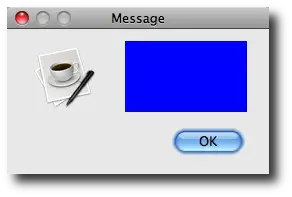| A Machine Learning Bestseller | |

|
Introduction to Machine Learning with Python |
As I mentioned in my JOptionPane showMessageDialog examples, you can easily create a JOptionPane dialog that shows a Java component. The component you show can be a JPanel a JScrollPane JLabel and many more things, anything that extends JComponent.
(The showMessageDialog method actually lets you add anything that is an instance of a Java Object, but as a practical matter, the only objects I can remember displaying in a JOptionPane dialog like this are Swing/GUI objects that extend JComponent.)
JOptionPane showMessageDialog component example
Here's the source code for a complete Java class that demonstrates how to show a JPanel in a JOptionPane dialog. This JOptionPane example displays a JPanel which I've given a blue background, and a minimum size of 200 pixels wide by 200 pixels tall:
import java.awt.Color;
import java.awt.Dimension;
import javax.swing.JFrame;
import javax.swing.JOptionPane;
import javax.swing.JPanel;
/**
* A JOptionPane showMessageDialog example that shows
* how to display a component (JComponent) in a
* JOptionPane dialog.
*/
public class ShowMessageDialogComponentExample
{
public static void main(String[] args)
{
// create a simple jpanel
JPanel panel = new JPanel();
panel.setBackground(Color.BLUE);
panel.setMinimumSize(new Dimension(200,200));
// display the jpanel in a joptionpane dialog, using showMessageDialog
JFrame frame = new JFrame("JOptionPane showMessageDialog component example");
JOptionPane.showMessageDialog(frame, panel);
System.exit(0);
}
}
When this JOptionPane example is compiled and run, it displays a JOptionPane dialog that looks like this:

Hopefully this is a simple example -- but a cool one -- because once you realize you can show any JComponent you want in a JOptionPane dialog, what you can achieve now is only limited by your creativity and imagination.
| A Machine Learning Bestseller | |

|
Machine Learning for Absolute Beginners |
Three JOptionPane showMessageDialog method signatures
I showed the showMessageDialog signature in my earlier JOptionPane showMessageDialog tutorial, but it is also useful to show those three different showMessageDialog method signatures here as well. The first showMessageDialog method signature looks like this:
showMessageDialog(Component parentComponent,
Object message)
The second JOptionPane showMessageDialog method looks like this:
showMessageDialog(Component parentComponent,
Object message,
String title,
int messageType)
And the third JOptionPane showMessageDialog method signature looks like this:
showMessageDialog(Component parentComponent,
Object message,
String title,
int messageType,
Icon icon)
Note that each of these JOptionPane showMessageDialog methods allow the Object message parameter, which is the parameter I pass into the method to display a component.
| A Machine Learning Bestseller | |

|
Machine Learning for Absolute Beginners |



